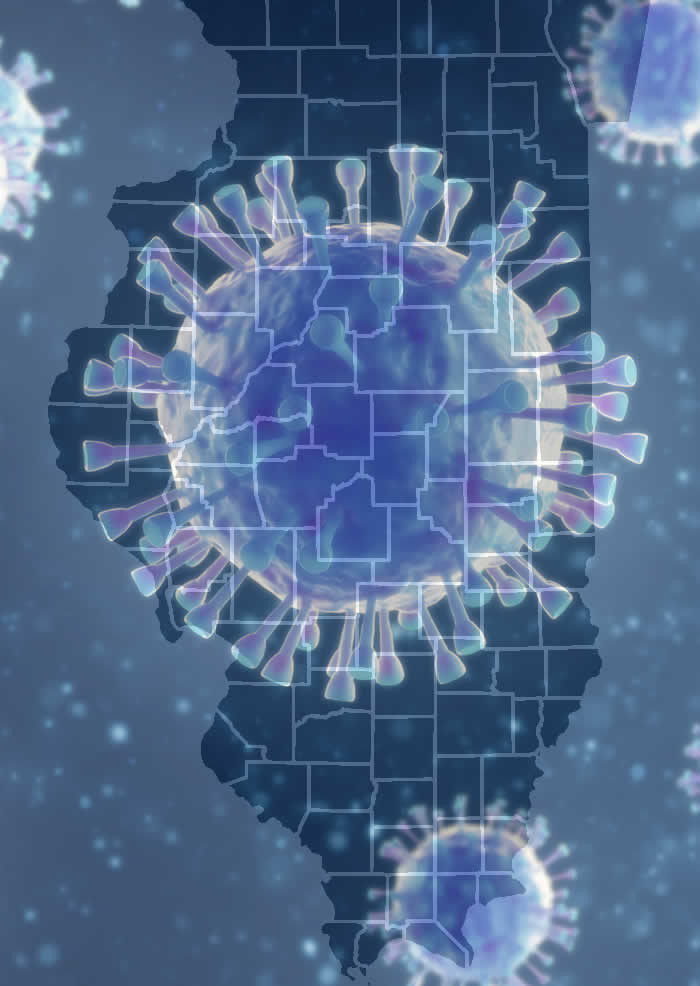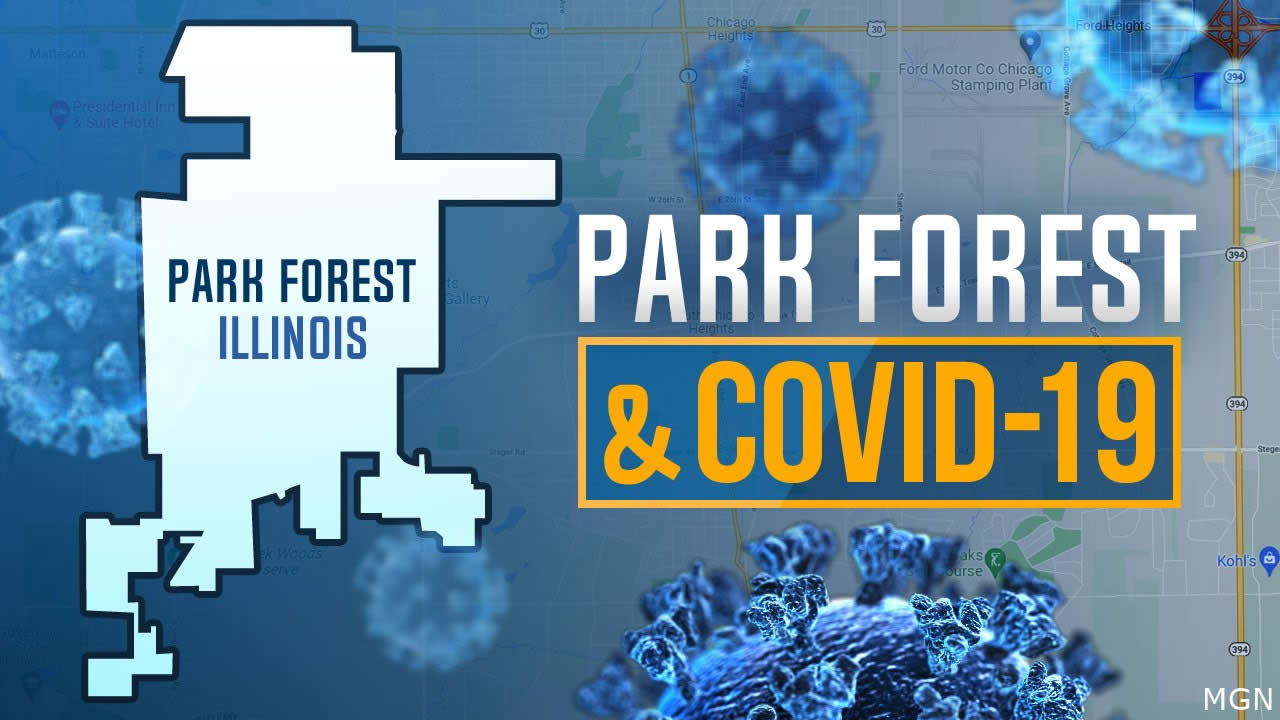
Park Forest, IL-(ENEWSPF)- The Cook County section of Park Forest has seen a 10.7% increase in the number of COVID-19 cases in the last 14 days according to the Cook County Department of Public Health. By contrast, Calumet City, with a population of over 37,000 people, has seen an 11.5% decrease in confirmed new cases over the same time period.
This puts Park Forest in the red, along with neighboring Chicago Heights (+7.55%), Matteson (+11.1%), and Richton Park (+11.5%).
Our data table for the percentage rise or fall of our 30 towns follows. Towns marked “N/A” are either marked so by Cook County because their change was negligible or because they are in Will County. We do not have 14-day statistics for Will County as the Will County COVID-19 Response page does not track this data yet.
Please note: This table is actually our live Google spreadsheet and will update as we update that sheet.
Statistics regarding the change in respective 14-day periods for the 30 towns eNews Park Forest surveys are now included in the larger table below.
Overall, seven people have died since we last reported on statistics on August 15, from 500 to 507. Park Forest’s total casualties remain at 21. The total number of cases in our region has risen moderately by 1,430 from 14,535 to 15,965.
Numbers continue to rise state-wide. Illinois officials reported 1,992 new cases of coronavirus today, August 30, and 11 confirmed deaths, lifting the statewide total of positive confirmed cases to 233,355. The number of deaths for the state now stands at 8,019 people.
Counties at Warning Level
The Illinois Department of Public Health (IDPH) on Friday reported 30 counties in Illinois are considered to be at a warning level for novel coronavirus disease (COVID-19). A county enters a warning level when two or more COVID-19 risk indicators that measure the amount of COVID-19 increase.
Cook County is now one of those counties.
Thirty counties are currently reported at a warning level – Bureau, Carroll, Cass, Clinton, Cook, Cumberland, Effingham, Fayette, Greene, Grundy, Henderson, Henry, Jasper, Jersey, Jo Daviess, Johnson, Madison, Monroe, Morgan, Perry, Pike, Randolph, Sangamon, Shelby, St. Clair, Union, Warren, White, Will, and Williamson.
The state recorded 4,016,782 tests and shows a current recovery rate of 95%.
The dangers of the spread of COVID-19 are multiple and complex, as Dr. Timothy Angelotti, MD Ph.D., recently told eNews Park Forest, “The problem is it’s not about death, it’s not about the healthy people or the people that get very little illness from this. It’s about the surge that can happen in a hospital setting when you have a whole bunch of people get infected.
“Our biggest fear, and that’s what people don’t appreciate, that if you want a hospital full of people who are full of COVID then keep doing what we’re doing. Then all other medical care will go by the wayside until we get control of this. Do you want us to cancel elective surgeries again?”
Dr. Angelotti is an Associate Professor of Anesthesiology, Perioperative, and Pain Medicine (ICU) at the Stanford University Medical Center. His Ph.D. is in pharmacology, and our entire interview with Dr. Angelotti is forthcoming.
Where do we stand today with COVID-19?
Park Forest now has 665 cases and a rate of 3103.27 per 100,000.
Chicago Heights 853 cases, 61 more than when we last surveyed, and a current rate per 100k of 2817.41. Cicero leads still with 4045 and the highest rate of the 30 by far at 4821.85.
The overall recovery rate in Illinois remains at 95%. We have no data on how many people are suffering lingering effects of COVID nor does anyone know yet if some conditions those have since recovering will become chronic.
The Institute for Health Metrics and Evaluation (IHME), an independent global health research center at the University of Washington, predicts upwards of 317,312 people in the United States will die of the virus by December 1, 2020. That is an alarming change from the IHME’s prediction when we last surveyed, at the time 295,011 by December 1. Part of this rise, no doubt, is because of Illinois, where the number is forecasted to be 15,058, 9,995 when we last surveyed. Indiana is now forecasted to lose 6,414 by December 1. That figure was 4,560 when we last surveyed.
A total of 7,051 people in Park Forest have been tested with an overall positive test percentage of 9.43%, down slightly from 9.90% when we last surveyed.
The Will County Health Department reports 75 cases of COVID-19 in the Will County section of Park Forest as of August 27, 2020.
As of this writing, Steger has 142 cases, Flossmoor 168, and Richton Park 337. Olympia Fields has pushed past the 100 mark to 104, Sauk Village is at 181, Glenwood 239, Tinley Park 670, and South Chicago Heights has 112.
Harvey has 671 cases, Country Club Hills has 503 cases, Orland Park 981, Lynwood 293, Lansing 686, Homewood 385, South Holland 682, Markham 330, and Crete 268.
Ford Heights now has 48 cases, and Calumet City has 967.
Currently, IDPH is reporting a total of 233,355 cases, including 8,019 deaths, in 102 counties in Illinois. The age of cases ranges from younger than one to older than 100 years. Within the past 24 hours, laboratories have reported 43,693 specimens for a total of 4,016,782. The preliminary seven-day statewide positivity for cases as a percent of total test from August 23 – August 29 is 4.2%.
As of last night, 1,472 people in Illinois were reported to be in the hospital with COVID-19. Of those, 328 patients were in the ICU and 155 patients with COVID-19 were on ventilators.
As of August 27, 2020, there are a total of 50,119 confirmed cases of COVID-19 in suburban Cook County and 1,860 deaths; only 178 cases are in congregate settings, such as long term care facilities or nursing homes, are reporting one or more confirmed cases; 74 cases are in other settings, such as workplaces or large gatherings, with confirmed outbreaks; with a total of 479 outbreak-associated cases.
The data from Cook County includes all cases under the jurisdiction of the Cook County Department of Public Health (excludes Chicago, Evanston, Oak Park, Skokie, and Stickney Township). All numbers are provisional and subject to change.
As of this writing, Will County now reports 11,447, up from 9,754 confirmed cases when we last surveyed. There are now 359 deaths from COVID-19, 10 more than our last survey.
We note again: Other countries have fewer cases of COVID-19, far lower rates per 100k. The higher numbers are not an inevitability of testing. Testing alone is not the determining factor in higher numbers.
COVID-19 at Ludeman Center
According to the state of Illinois, as of August 28, Ludeman Center in Park Forest has 231 residents who tested positive for COVID-19, the same as when we last surveyed. Of these 231 residents who tested positive, 220 have recovered, the same, again, as when we last surveyed.
A total of 134 staff members at Ludeman have tested positive, two more since we last surveyed. Of these, 125 have recovered and returned to work.
Ludeman Center employs 919 people and has 336 residents according to the August 28 data.
As of August 7, three Ludeman Homes were still quarantined for droplet isolation, up from none when we last surveyed. This refers to precautions healthcare workers, visitors, and staff need to take “before going into or leaving a patient’s room.” These three homes are not available for in-person visits, Parents & Friends of the Ludeman Center report. “All other Unit 3 homes are cleared for in-person visits,” the group reports.
“Droplet precautions are for patients who have germs that can spread when they cough or sneeze.” (MyHealth.Alberta.CA)
All staff and residents at Ludeman Centerhave been tested, some twice, according to Parents & Friends. Staff continues to undergo wellness checks before reporting to their respective assignments, the group Parents & Friends reports.
Deceased from COVID-19
The Cook County Medical Examiner now reports 5,054 total COVID-19 related deaths since March 16, 2020. This figure is from today’s date, August 30, 2020.
As noted above, Park Forest has lost 21 people from COVID-19.
COVID-19 Deaths for 30 Towns
| Municipality | Total Deceased | Most Recent Population Figures | Rate per 100,000 Population*
|
| Calumet City | 9 | 37,042 | 24.30 |
| Chicago Heights | 37 | 30,276 | 122.21 |
| Cicero | 83 | 83,889 | 98.94 |
| Country Club Hills | 35 | 16,541 | 211.60 |
| Crestwood | 20 | 10,950 | 182.65 |
| Crete | 5 | 8,117 | 61.60 |
| Dolton | 23 | 23,153 | 99.34 |
| East Hazel Crest | 3 | 1,543 | 194.43 |
| Flossmoor | 9 | 9,464 | 95.10 |
| Ford Heights | 1 | 2,763 | 36.19 |
| Frankfort | 5 | 19,178 | 26.07 |
| Harvey | 23 | 25,282 | 90.97 |
| Glenwood | 7 | 8,969 | 78.05 |
| Hazel Crest | 16 | 14,100 | 113.48 |
| Homewood | 33 | 19,323 | 170.78 |
| Lansing | 12 | 28,331 | 42.36 |
| Lynwood | 2 | 9,007 | 22.20 |
| Markham | 16 | 12,508 | 127.92 |
| Matteson | 24 | 19,009 | 126.26 |
| Oak Forest | 9 | 27,962 | 32.19 |
| Olympia Fields | 4 | 4,988 | 80.19 |
| Orland Park | 36 | 56,582 | 63.62 |
| Park Forest | 21 | 21,429 | 98.00 |
| Richton Park | 14 | 13,646 | 102.59 |
| Sauk Village | 2 | 10,506 | 19.04 |
| South Chicago Heights | 0 | 4,139 | 0.00 |
| South Holland | 36 | 22,030 | 163.41 |
| Steger | 5 | 9,331 | 53.58 |
| Tinley Park | 11 | 49,235 | 22.34 |
| University Park | 6 | 6,958 | 86.23 |
| Combined | 507 | 606,251 | 83.63 |
*Numbers per 100,000 based on most recent population from US Census.gov or derived via formulat using rate per 100,000 population and COVID-19 cases as reported by Cook County. |
|||
The City of Chicago has lost 2,702 people to COVID-19, 39 more people since we last tallied.
As previously mentioned, the state of Illinois reports an overall recovery rate of 95%. According to the IDPH, the recovery rate is calculated as the recovered cases divided by the sum of recovered cases and deceased cases. Recovered cases are defined as persons “with an initial positive specimen collection date” who after more than 42 days “have not expired,” according to the IDPH.
Current COVID-19 Cases for 30 South Suburban Towns
| Municipality | COVID-19 Cases | Most Recent Population Figures | Rate per 100,000 Population* | 14-day % Change |
| Calumet City | 967 | 37,042 | 2,610.55 | -11.5% |
| Chicago Heights | 853 | 30,276 | 2,817.41 | +7.55% |
| Cicero | 4,045 | 83,889 | 4,821.85 | +10.6% |
| Country Club Hills | 503 | 16,541 | 3,040.93 | -16.2% |
| Crestwood | 198 | 10,950 | 1,808.22 | +90.9% |
| Crete | 268 | 8,117 | 3,301.71 | N/A |
| Dolton | 593 | 23,153 | 2,561.22 | -43.6% |
| East Hazel Crest | 28 | 1,543 | 1,814.65 | N/A |
| Flossmoor | 168 | 9,464 | 1,775.15 | -14.3% |
| Ford Heights | 48 | 2,763 | 1,737.24 | N/A |
| Frankfort | 369 | 19,178 | 1,924.08 | N/A |
| Glenwood | 239 | 8,969 | 2,664.73 | -7.14% |
| Harvey | 671 | 25,282 | 2,654.06 | -21.9% |
| Hazel Crest | 355 | 14,100 | 2,517.73 | -16.7% |
| Homewood | 385 | 19,323 | 1,992.44 | -13.8% |
| Lansing | 686 | 28,331 | 2,421.38 | +17.6% |
| Lynwood | 203 | 9,007 | 2,253.80 | -56.5% |
| Markham | 330 | 12,508 | 2,638.31 | -60.0% |
| Matteson | 582 | 19,009 | 3,061.71 | +11.1% |
| Oak Forest | 412 | 27,962 | 1,473.43 | +81.5% |
| Olympia Fields | 104 | 4,988 | 2,085.00 | -16.7% |
| Orland Park | 981 | 56,582 | 1,733.77 | +4.39% |
| Park Forest | 665 | 21,429 | 3,103.27 | +10.7% |
| Richton Park | 337 | 13,646 | 2,469.59 | +11.5% |
| Sauk Village | 181 | 10,506 | 1,722.83 | -45.5% |
| South Chicago Heights | 112 | 4,139 | 2,705.97 | N/A |
| South Holland | 682 | 22,030 | 3,095.78 | -18.2% |
| Steger | 142 | 9,331 | 1,521.81 | N/A |
| Tinley Park | 670 | 49,235 | 1,360.82 | +17.6% |
| University Park | 188 | 6,958 | 2,701.93 | N/A |
| Combined | 15,965 | 606,251 | 2633.40 | |
*Numbers per 100,000 based on most recent population from US Census.gov or derived via formula using rate per 100,000 population and COVID-19 cases as reported by Cook County. |
||||
The following chart will auto-update as we update our Google spreadsheet:
State of Illinois: Most Recent Update
The Illinois Department of Public Health (IDPH) on August 30 announced 1,992 new confirmed cases of coronavirus disease (COVID-19) in Illinois, including 11 additional confirmed deaths.
- Bureau County: 1 male 70s
- Cook County: 1 female 30s, 2 females 50s, 1 female 60s, 2 males 60s, 2 females 70s
- Lake County: 1 female 80s
- Madison County: 1 female 70s
Currently, IDPH is reporting a total of 233,355 cases, including 8,019 deaths, in 102 counties in Illinois. The age of cases ranges from younger than one to older than 100 years. Within the past 24 hours, laboratories have reported 43,693 specimens for a total of 4,016,782. The preliminary seven-day statewide positivity for cases as a percent of total test from August 23 – August 29 is 4.2%. As of last night, 1,472 people in Illinois were reported to be in the hospital with COVID-19. Of those, 328 patients were in the ICU and 155 patients with COVID-19 were on ventilators.
Following guidance from the Centers for Disease Control and Prevention, IDPH is now reporting both confirmed and probable cases and deaths on its website. Reporting probable cases will help show the potential burden of COVID-19 illness and efficacy of population-based non-pharmaceutical interventions. IDPH will update these data once a week.
*All data are provisional and will change. In order to rapidly report COVID-19 information to the public, data are being reported in real-time. Information is constantly being entered into an electronic system and the number of cases and deaths can change as additional information is gathered. For health questions about COVID-19, call the hotline at 1-800-889-3931 or email [email protected].
Thirty Illinois Counties at Warning Level for Coronavirus Disease
The Illinois Department of Public Health (IDPH) on Friday reported 30 counties in Illinois are considered to be at a warning level for novel coronavirus disease (COVID-19). A county enters a warning level when two or more COVID-19 risk indicators that measure the amount of COVID-19 increase.
Thirty counties are currently reported at a warning level – Bureau, Carroll, Cass, Clinton, Cook, Cumberland, Effingham, Fayette, Greene, Grundy, Henderson, Henry, Jasper, Jersey, Jo Daviess, Johnson, Madison, Monroe, Morgan, Perry, Pike, Randolph, Sangamon, Shelby, St. Clair, Union, Warren, White, Will, and Williamson.
Although the reasons for counties reaching a warning level varies, some of the common factors for an increase in cases and outbreaks are associated with weddings, large gatherings, long-term care facilities and other congregate settings, travel to neighboring states, bars, and spread among members of the same household who are not isolating at home. Cases connected to schools are beginning to be reported. General transmission of the virus in the community is also increasing.
Public health officials are observing people not social distancing, gathering in large groups, and not using face coverings. In some counties, local law enforcement and states’ attorneys are not enforcing important mitigation measures like social distancing and the wearing of face coverings.
Several counties are taking swift action and implementing mitigation measures to help slow spread of the virus, including increasing testing opportunities, working with schools, meeting with local leaders, and educating businesses and large venues about the importance of mitigation measures.
IDPH uses numerous indicators when determining if a county is experiencing stable COVID-19 activity, or if there are warning signs of increased COVID-19 risk in the county. A county is considered at the warning level when at least two of the following metrics triggers a warning.
- New cases per 100,000 people. If there are more than 50 new cases per 100,000 people in the county, this triggers a warning.
- Number of deaths. This metric indicates a warning when the weekly number of deaths increases more than 20% for two consecutive weeks.
- Weekly test positivity. This metric indicates a warning when the 7-day test positivity rate rises above 8%.
- ICU availability. If there are fewer than 20% of intensive care units available in the region, this triggers a warning.
- Weekly emergency department visits. This metric indicates a warning when the weekly percent of COVID-19-like-illness emergency department visits increase by more than 20% for two consecutive weeks.
- Weekly hospital admissions. A warning is triggered when the weekly number of hospital admissions for COVID-19-like-illness increases by more than 20% for two consecutive weeks.
- Tests perform. This metric is used to provide context and indicate if more testing is needed in the county.
- Clusters. This metric looks at the percent of COVID-19 cases associated with clusters or outbreaks and is used to understand large increase in cases.
These metrics are intended to be used for local level awareness to help local leaders, businesses, local health departments, and the public make informed decisions about personal and family gatherings, as well as what activities they choose to do. The metrics are updated weekly, from the Sunday-Saturday of the prior week.
A map and information of each county’s status can be found on the IDPH website at https://www.dph.illinois.gov/countymetrics.
About the Elisabeth Ludeman Center
As of June 17, the latest date that data is available, the Illinois Department of Human Services reports a current census of 339 residents at Ludeman Center. Of these:
- The average age is 53.4 years (22 – 77);
- 72% of the residents are severe and profound mentally, intellectually, and physically disabled.
- 52% are non-verbal, using sign language or gestures to communicate;
- 58% have a behavior intervention program, often requiring higher
levels of staff supervision; - 63% receive psychotropic medications.
The Elisabeth Ludeman Center occupies 60 acres in Park Forest at the southwest corner of Orchard Drive and North Street.
The Center is divided into three (3) residential units comprised of 13-14 homes. Each unit has a centrally located Neighborhood House which has offices for the Unit Director, Social Worker, Unit Physician, Nursing Personnel, Qualified Intellectual Disabilities Professionals, (QIDP’s), Residential Services Supervisors and clerical personnel. The Ludeman Center also serves as an admission center for individuals having significant adaptive issues in the community-based setting. The Interdisciplinary teams’ main priority is to stabilize and ensure a successful transition back into the community.
Each of the 40 ranch-style homes has a kitchen, dining/living room area, utility room which contains a washer and dryer, two full and one half bathrooms, and five bedrooms.
Approximately half of the people who currently reside at the Ludeman Center attend vocational training programs at community training sites or workshops. The remainder of the people are served in on-campus day training programs. Currently, several individuals are working in a food service program, housekeeping program, horticulture program (vegetable garden and greenhouse flowers) and in the Center-wide recycling program.
Finally, the Ludeman Center has opened its doors and shared space/services with the Illinois Department Of Transportation’s District 1 South DBE Resource Center; as well as the Office of the Inspector General, Bureau of Civil Affairs, Bureau of Quality Management, and SODC Operations.
*Why Rate Per 100,000?
We found a clear explanation for viewing the rate of infections per 100,000 comes from Indiana University at Bloomington: “There may or may not be 100,000 residents in the county under review, but multiplying the result by 100,000 makes that rate comparable with counties with more than 100,000 or less than 100,000.”
“It is customary to use rates per 100,000 population for deaths and rates per 1,000 population for live births,” our source at Indiana University says.
So, none of the cities, towns, and villages we survey have 100,000 residents, but by using the rate per 100,000, we are able to compare apples to apples, so to speak, as if every town did have 100,000 residents.
eNews Park Forest will continue to track the effects the COVID-19 pandemic has on our region.








